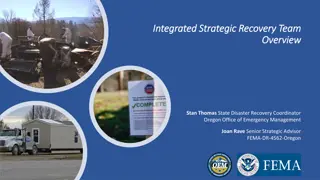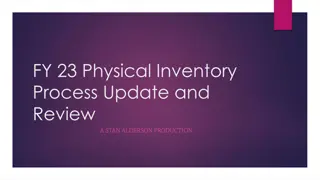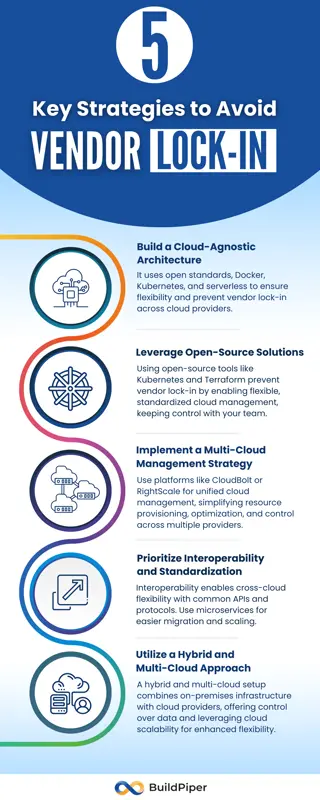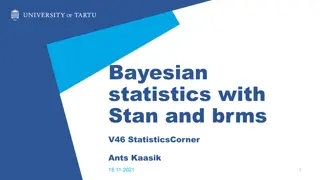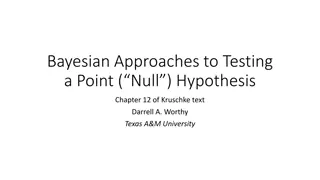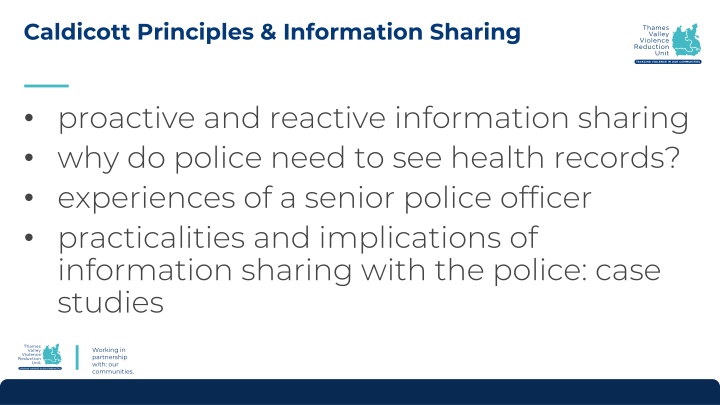
Information Sharing for Crime Prevention and Public Safety
Explore the importance of sharing health records with the police, the role of community partnerships in preventing violence, and the legislative basis for information sharing. Learn about initiatives like Violence Reduction Units and the Serious Violence Duty in the Police, Crime, Sentencing, and Courts Bill 2021.
Uploaded on | 0 Views
Download Presentation

Please find below an Image/Link to download the presentation.
The content on the website is provided AS IS for your information and personal use only. It may not be sold, licensed, or shared on other websites without obtaining consent from the author. If you encounter any issues during the download, it is possible that the publisher has removed the file from their server.
You are allowed to download the files provided on this website for personal or commercial use, subject to the condition that they are used lawfully. All files are the property of their respective owners.
The content on the website is provided AS IS for your information and personal use only. It may not be sold, licensed, or shared on other websites without obtaining consent from the author.
E N D
Presentation Transcript
Caldicott Principles & Information Sharing proactive and reactive information sharing why do police need to see health records? experiences of a senior police officer practicalities and implications of information sharing with the police: case studies Working in partnership with: our communities.
Intercept Points: Who we want to reach 0 2 Navigator 1 Children and young people identified by the police, or others (including through data), as at high risk of suffering harm. Prior to charge, remand, or court appearance. At point of injury. At point of arrest. Working in partnership with: our communities.
Police, Crime, Sentencing and Courts Bill 2021: Serious Violence Duty Violence Reduction Units (VRUs) bring together community leaders and other key partners with police, local government, health and education professionals to identify the drivers of serious violence and develop a response to them. VRUs will ensure there is effective planning and collaboration to support a longer term approach to preventing violence. The new duty will complement and assist the VRUs in their aim of preventing and reducing serious violence, by providing a strategic platform with the right regulatory conditions to support successful delivery of this multi agency approach, including through the extended set of partners on whom the duty will fall. The Serious Violence Duty Serious Violence Duty will require local authorities, the police, fire and rescue authorities, specified criminal justice agencies and health authorities to work together to formulate an evidence based analysis of the problems associated with serious violence in a local area, and then produce and implement a strategy detailing how they will respond to those particular issues. Prisons, youth custody agencies and educational authorities may also need to work with these core partners. Working in partnership with: our communities.
Legislative basis for information sharing and processing Legislative basis for information sharing and processing SENSITIVEDATA USEOFPERSONALDATA SPECIALCATEGORYDATA * SCHEDULE 1, PART 2 (6) Statutory etc. and government purposes 6(1)This condition is met if the processing (a)is necessary for a purpose listed in sub- paragraph (2), and (b)is necessary for reasons of substantial public interest. (2)Those purposes are (a)the exercise of a function conferred on a person by an enactment or rule of law; (b)the exercise of a function of the Crown, a Minister of the Crown or a government department. Data Protection Act 2018 (legislation.gov.uk) Data Protection Act (DPA) 2018 PART 1 SECTION 31 For the purposes of this Part, the law enforcement purposes are the purposes of the prevention, investigation, detection or prosecution of criminal offences or the execution of criminal penalties, including the safeguarding against and the prevention of threats to public security: Data Protection Act 2018 (legislation.gov.uk) PART 3 SCHEDULE 8 SECTION 1 Statutory etc. purposes 1This condition is met if the processing (a)is necessary for the exercise of a function conferred on a person by an enactment or rule of law, and (b)is necessary for reasons of substantial public interest. Data Protection Act 2018 (legislation.gov.uk) NEW DOMESTIC ABUSEACT 2021 PART 4 LOCAL AUTHORITYSUPPORT Domestic Abuse Act 2021 (legislation.gov.uk) SUPPORTINGLEGISLATIONANDPOLICYREFERENCES ARTICLE 9(G) processing is necessary for reasons of substantial public interest, on the basis of Union or Member State law which shall be proportionate to the aim pursued, respect the essence of the right to data protection and provide for suitable and specific measures to safeguard the fundamental rights and the interests of the data subject; Art. 9 GDPR Processing of special categories of personal data - General Data Protection Regulation (GDPR) (gdpr-info.eu) CRIME & DISORDER ACT 1998, SECTION 115 gives partners the power to share information for the purpose of reducing crime and disorder. Crime and Disorder Act 1998 (legislation.gov.uk) CHILDREN S ACT 2004, SECTION 11 requires that the Chief Constable and policing body must make arrangements for ensuring that their functions are discharged having regard to the need to safeguard and promote the welfare of children . Children Act 2004 (legislation.gov.uk) DIGITAL ECONOMY ACT 2017, SECTION 35 allows for information sharing between public authorities for public service delivery objectives as specified in the Act. Digital Economy Act 2017 (legislation.gov.uk) MANAGEMENTOF POLICE INFORMATION (MOPI) 2005 Management of police information (college.police.uk) ARTICLE 6(E) processing is necessary for the performance of a task carried out in the public interest or in the exercise of official authority vested in the controller; Art. 6 GDPR Lawfulness of processing - General Data Protection Regulation (GDPR) (gdpr-info.eu) GDPR Working in partnership with: our communities.
Information sharing principles Necessary and proportionate Necessary and proportionate Timeliness is key in emergency situations and it may not be appropriate to seek consent for information sharing if it could cause delays and therefore place a child or young person at increased risk of harm. Practitioners should ensure that sufficient information is shared, as well as consider the urgency with which to share it. When taking decisions about what information to share, you should consider how much information you need to release. Not sharing more data than is necessary to be of use is a key element of the GDPR and Data Protection Act 2018, and you should consider the impact of disclosing information on the information subject and any third parties. Information must be proportionate to the need and level of risk. Secure Secure Wherever possible, information should be shared in an appropriate, secure way. Practitioners must always follow their organisation s policy on security for handling personal information. Relevant Relevant Only information that is relevant to the purposes should be shared with those who need it. This allows others to do their job effectively and make informed decisions. Record Record Information sharing decisions should be recorded, whether or not the decision is taken to share. If the decision is to share, reasons should be cited including what information has been shared and with whom, in line with organisational procedures. If the decision is not to share, it is good practice to record the reasons for this decision and discuss them with the requester. In line with each organisation s own retention policy, the information should not be kept any longer than is necessary. In some rare circumstances, this may be indefinitely, but if this is the case, there should be a review process scheduled at regular intervals to ensure data is not retained where it is unnecessary to do so Adequate Adequate Information should be adequate for its purpose. Information should be of the right quality to ensure that it can be understood and relied upon. Accurate Accurate Information should be accurate and up to date and should clearly distinguish between fact and opinion. If the information is historical then this should be explained. Timely Timely Information should be shared in a timely fashion to reduce the risk of missed opportunities to offer support and protection to a child. https://assets.publishing.service.gov.uk/government/uploads/system/u ploads/attachment_data/file/721581/Information_sharing_advice_practi tioners_safeguarding_services.pdf Working in partnership with: our communities.
Data Protection Act 2018 Schedule 2 Exemptions Schedule 2, part 1. If a disclosure becomes necessary then the duty of confidentiality has to be respected to the extent compatible with achieving that purpose. Any disclosure therefore has to be both necessary and proportionate. Anyone considering a public interest disclosure must therefore have a reasonable belief that it will achieve its purpose and disclose only so much information as is necessary to achieve it. 2(1) The listed GDPR provisions and Article 34(1) and (4) of the GDPR (communication of personal data breach to the data subject) do not apply to personal data processed for any of the following purposes ( (a) the a) the prevention or detection of prevention or detection of crime, crime, ( (b) the b) the apprehension or apprehension or prosecution of prosecution of offenders offenders Working in partnership with: our communities.
Vital Interest - DPA 2018 Sched1(18) This condition is met if (a) the processing is necessary for the purposes of (i) protecting an individual from neglect or physical, mental or emotional harm, or (ii) protecting the physical, mental or emotional well-being of an individual, (b) the individual is (i) aged under 18, or (ii) aged 18 or over and at risk, (c) the processing is carried out without the consent of the data subject for one of the reasons listed in sub-paragraph (2), and (d) the processing is necessary for reasons of substantial public interest. Working in partnership with: our communities.
Flowchart for Safeguarding https://assets.publishing.service.gov.uk/government/uploads/system/u ploads/attachment_data/file/721581/Information_sharing_advice_practi tioners_safeguarding_services.pdf Does the Does the common law duty of confidence common law duty of confidence and the Human Rights Act 1998 prevent and the Human Rights Act 1998 prevent the sharing of personal the sharing of personal information? No No - - this is not the case. In addition to the this is not the case. In addition to the GDPR and Data Protection Act 2018, GDPR and Data Protection Act 2018, practitioners need to balance the common practitioners need to balance the common law duty of confidence, and the rights law duty of confidence, and the rights within the Human Rights Act 1998, against within the Human Rights Act 1998, against the effect on children or individuals at risk, the effect on children or individuals at risk, if they do not share the information. if they do not share the information. information? Working in partnership with: our communities.
Necessary and Proportionate? What is the objective that underpins the request? Is the request under review rationally connected with that objective? Is the requested information necessary in order to achieve that objective, or is a less intrusive option available? Does the measure achieve a fair balance between the interests of the individual(s) affected and the wider community? What is the justification (e.g., how serious is the offence v how intrusive is the request)? Working in partnership with: our communities.
Proactive or Reactive? Proactive Proactive Reactive Reactive For example, personal information For example, personal information you may give about a patient when you may give about a patient when you report a crime to the police. you report a crime to the police. For example, personal information For example, personal information you give about a patient in you give about a patient in response to a request from the response to a request from the police. police. After an incident, or After an incident, or To prevent harm To prevent harm Working in partnership with: our communities.
Case Studies - 1 A Police Officer comes to you and explains that a suspect in an assault has been described in such a way that they believe you may hold information that could help identify who they are looking for, could you tell them if a young person has been in today with a head injury Discuss Discuss Working in partnership with: our communities.
Case Studies - 2 A Police Officer comes to you and explains that a victim in an assault has been described in such a way that they believe you may hold information that could help identify who they are looking for, could you tell them if a young person has been in today with a head injury Discuss Discuss Working in partnership with: our communities.
Case Studies - 3 You are asked to provide information to a murder investigation. A woman has been killed and her son is a suspect, he is described as a serial abuser . Can you provide his and their other children s medical records for examination please. Discuss Discuss Working in partnership with: our communities.
Case Studies - 4 You are contacted by the police, they are searching for a High Risk Missing 79 year old man. Discuss Discuss They would like to know details of his medication. Working in partnership with: our communities.
Missing or AWOL Multi-agency protocols on missing or AWOL patients The Mental Health Act 1983 Code of Practice (for England) and the Mental Health Act 1983 Code of Practice (for Wales) both require that forces and agencies develop a joint protocol for the search and recovery of AWOL patients, including using warrants under section 135(2) MHA 1983. This protocol should be created and maintained between police forces, hospitals, mental health unit facilities and ambulance services at a local level. It should include the duties of the police and NHS staff before, during and after making reports. https://www.app.college.police.uk/app-content/mental-health/awol- patients/#multi-agency-protocols-on-missing-or-awol-patients https://www.met.police.uk/SysSiteAssets/media/downloads/central/advice/herbert- protocol/herbert-protocol-form.pdf Working in partnership with: our communities.
Case Studies - 5 You are contacted by the police, they are dealing with a woman who is threatening to jump from a bridge. Discuss Discuss They would like to know anything that could help with her mental state. Working in partnership with: our communities.
Discussion Case Study Discussion: Discussion:- - Objective: Objective: DPA 2018 Sched1(18) (a)(i) - Protecting an individual from neglect or physical, mental or emotional harm. Request: Request: Please provide information you hold on the recent treatment given to Child A. Justification: Justification: Child A is missing from home and is at risk of harm, we want to ascertain if the treatment given would add additional risk to the current assessment, or provide additional opportunities to locate them. What are your What are your considerations? considerations? How might you How might you respond? respond? Working in partnership with: our communities.






